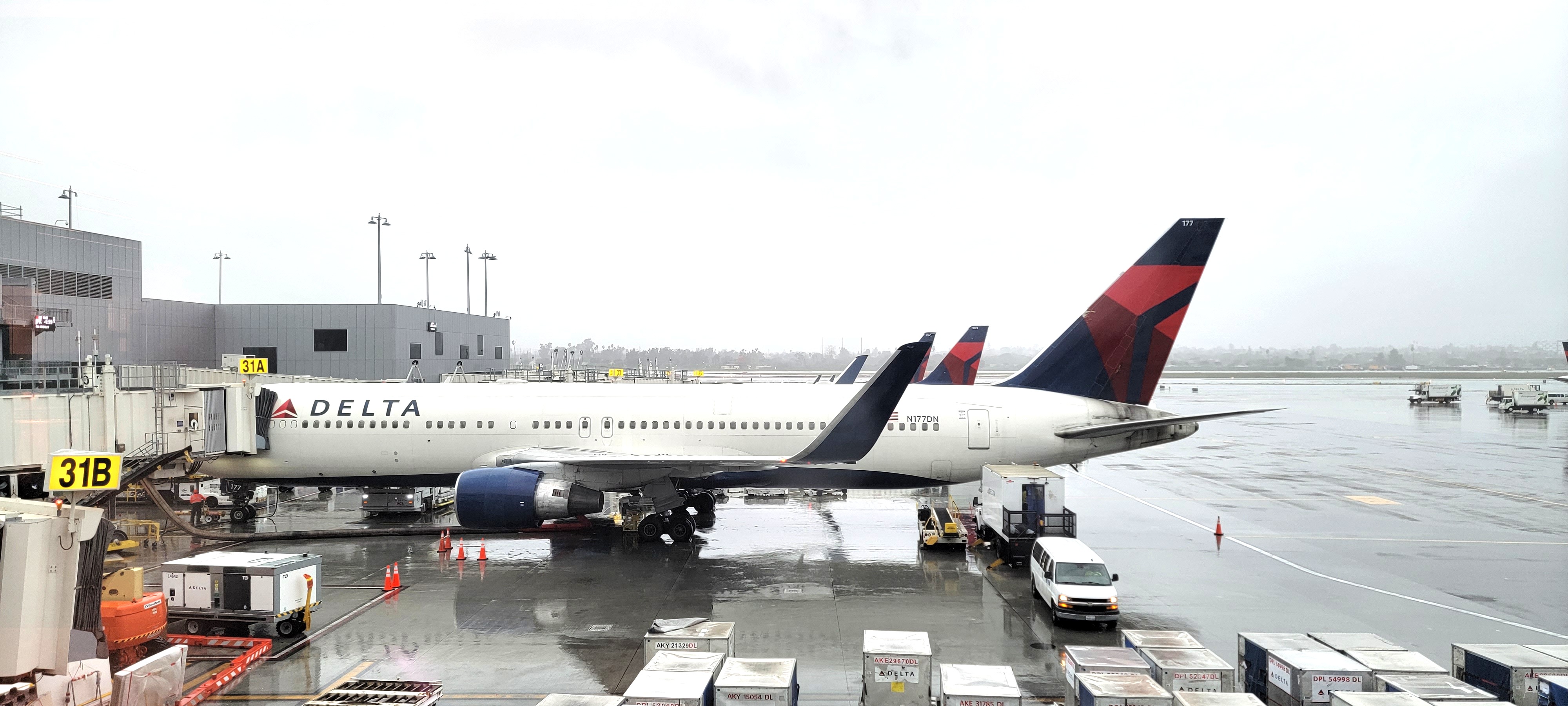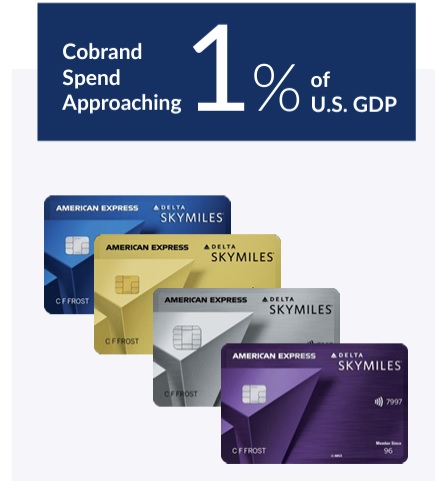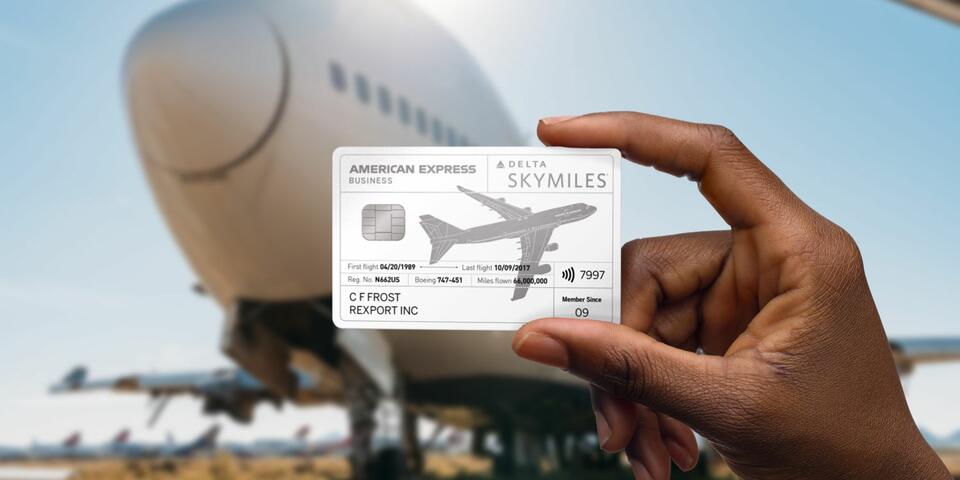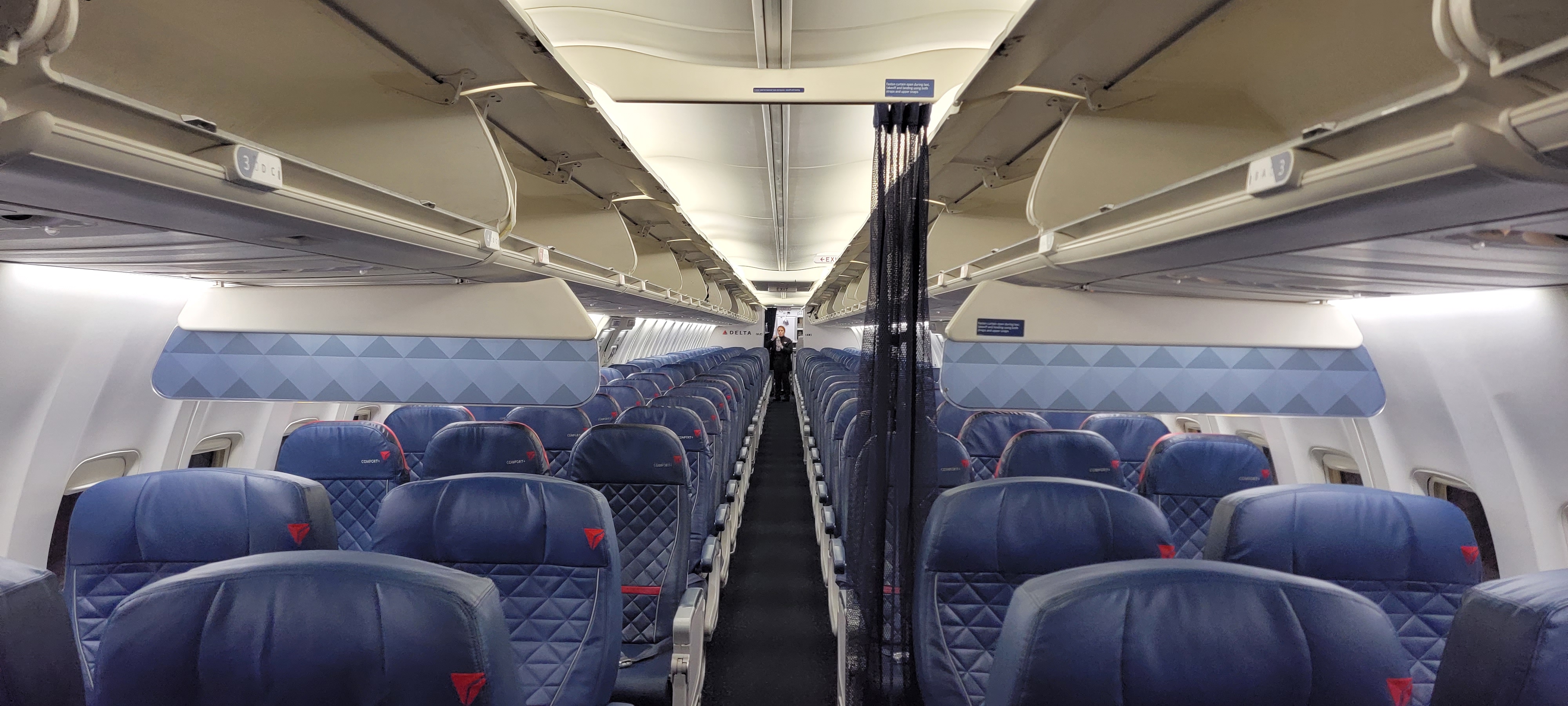For a long time, financial analysts and the general public have come to realize that airlines are no longer just ways of moving people from place to place. They’re credit cards with wings.
- Some carriers often lose money just flying people and cargo alone (American Airlines)
- Others may make money flying, but make the bulk of profit from their bank partner (Delta)
- And in any case, frequent flyer revenue is very high margin (39% – 53%, depending on how the airline does their internal math)

What’s changing now, though, is that airlines have started to choose where to fly based on how that will influence customer spending behavior on their credit cards.
During Thursday’s third quarter earnings call, Delta reported $2 billion in revenue from American Express for the quarter and projected being on track for $8 billion in revenue for the full year. They’ve previously shared that spend on their cobrands is ‘approaching’ 1% of U.S. GDP.

While they talk about a “long-term goal” of generating $10 billion a year from this relationship, that’s something they had projected for 2029 before the pandemic – that didn’t have 20% pandemic-era inflation baked in. So they’re actually behind where they expected to be at this point.
The airline shared that one-third of active SkyMiles members have co-brand Amex cards currently. That tells me they continue to be topped out in terms of finding new customers for these cards, though they continue to report record cardmember acquisitions (it’s unclear how many of those new cardmembers are previous cardmembers, and what their retention of these customers will be after the first year). They are on their “seventh year of a million or more” acquisitions.
They’ve leaned into driving more spend out of existing customers, and they’re building new routes and building up markets so to attract more card customers.
- As they raise annual fees and layer on card benefits, they’re finding this attracts better credit score customers with higher card spend (and higher approval rates). Ed Bastian is assured that “as long as you’re providing good value to customers there’ll be strong demand for products at higher fees.”

- And, Delta says, it helps explain their big growth in Austin and Raleigh – with CEO Ed Bastian sharing that “these are places we acquire a lot of cards.” They no longer just look at profitabilty route-by-route but want to understand where potential cardmember growth lies, and what flights will attract cardmember spend.

Credit card deals aren’t just the profitability engine of airlines, they now drive where airlines fly. And it isn’t just Delta.
- A key reason Southwest went into Hawaii (and also why they need premium products, international and partners) is to drive cobrand spend. Cardmembers need aspirational destinations to motivate them to get the card and keep it top of wallet.
- When Scott Kirby joined United he laid out card acquisition and spend as a key rationale for restoring the airline’s domestic route network. He argued that being number one in a market produced outsized credit card uptake, and that relevance in a market was needed to generate card spend. And we’ve seen some of the ‘sexier’ routes United has added clearly supported by aspirational redemption bets – destinations like Nuuk, Greenland; Bilbao, Spain; and Faro and Madeira, Portugal.
- Meanwhile American has been hurt (their card spend volume has dropped from first to third) because of weakenss in high spend markets. They’ve pulled back in Los Angeles, New York and Chicago. In fact, they retired too many planes during the pandemic and lacked the aircraft to build Chicago back up, and are now slated to lose O’Hare gates. Retiring widebodies and focusing on short haul flying and the Sun Belt, they’ve lost some of the drivers of aspirational points acquisition, though they still have far-flung partnerships. (Their close partnership with Fiji Airways isn’t just a benefit to Fiji.)

What this also points to is the changing way that airlines think about how to attribute cobrand revenue to their operations. It doesn’t show up in passenger revenue in the financials, but internally you allocate card spend to the markets where cardmembers live.
It used to be that an airline might just spread out total card revenue across all flights, or at a macro level look at ‘total revenue’ per available seat mile instead of passenger revenue per seat mile and compare that to cost.
Bank partner revenue needs to go to the market where the customers live, to understand what’s driving that revenue and the real profitability of a flight. Ticket price might not cost a flight but if the flight makes an airline relevant to customers in a market to spend on their product it may still be profitable.


As long as they operate reliably, I am okay with this (credit cards with wings.) And, in some cases, our credit cards are literally repurposed metal from old planes (see the limited-edition Delta Reserve Amex cards from the old 747 aircraft).
I can earn more SkyMiles from a Membership Rewards card (with transferrable points) than from a Delta cobranded card. That makes no sense. Airlines for some reason are not capitalizing on the brand marketing opportunity that is a consumer pulling out their card at a restaurant to pay the bill.
That’s fine now but it is at risk to crashing one day.
Credit card usage can be very fickle depending on a sign on bonus. Credit card profits are made on the backs of small and medium sized businesses that have consumers as customers (instead of other businesses). Some of the fees are high. Gary likes to think that credit cards are wonderful for the merchant but that is not always true. What is true is the entire cost of this credit card scheme, other than the sign on bonuses, are on the backs of the merchant.
Some people don’t travel much. Others may realize that certain currencies, like Delta Skypesos are not worth too much and that 2% cash back is better. Other big spenders might find that they only need one business class ticket for a vacation per year and don’t need that many miles.
A lot of variables. Things can change.
AI and Credit Cards now running our lives! How much more fun can this get?
@derek — So, back to Rule #1, then: Don’t hoard points. Earn ’em and burn ’em. Mitigate risk of devaluations, shutdowns.
Gary’s post about CAVA’s “status” program earlier today is illustrative for the types of things I would be thinking about if I ran a loyalty program. Rewards Network for instance partners with AA, DL, UA, Bilt, Rakuten, etc. and runs their dining loyalty program. That’s great, and i’m sure the airlines get a cut, but you don’t get anything different for being an airline status member (becoming an AA Dining VIP is just based on number of visits per year to any restaurant, not like AA hotels where you get 5-10x points for being a status member / CC holder). Feels like Rewards Network itself is more interested in restaurant financing versus truly incentivizing consumer spend through to the credit card.
Just feels like there is a golden opportunity to make those “stars” align a bit more in terms of driving more CC spend. Perhaps Amex is on the right path with Resy credits, but then has not connected the dots back to Delta. Would expect we will see more on this front over the next few years.
Given the terrible value proposition of Delta points, the only acceptable spend on on their cobranded cards (outside of SUBs) is for loyalty status, correct? If so, how are so many people spending so much on these cards??? I really don’t understand it, Delta has lead the way in destroying the value of their points how on earth on consumer responding by accruing them.
> aspirational redemption bets – destinations like Nuuk, Greenland
WTF?
@toomanybooks — According to reviews and flight records, United barely even operated that route this summer, frequently delayed and canceled, leaving folks stranded. And yet, they say they’re bringing it back next year… oof.
Everyone is missing the point. The customers are driven by STATUS! Delta miles are relatively less valuable, but the MQDs are not. Diamond Choice benefits are unparalleled. United Plus Points and American SWUs are fairly useless, but Delta RUCs and GUCs are easy to use and quite valuable.
@Gene — Now, you’re speakin’ my language! Woop woop!
Everyone has a take on what is and is not useless about a loyalty program. Comes down to individual needs and what you value. I find elite status on DL good for one two things: early boarding so I get my bag in the overhead and preferential assistance during IRROPS. UGs are worthless (even as a 2MM DM), Limited seats in EC make that hit or miss. Diamond Choice benefits are marginal, so I always take the travel vouchers. No one I’m gifting status to and I really do not need another Tumi gift card.
Personally, DL’s comment today solidifies a few things in my mind:
1. DL has fully pivoted to a lifestyle brand, not an airline. They make their money through credit card deals and selling miles to their preferred network of vendors.
2. DL cares more about cc spend than they do loyalty, repeat business, their hard product, their soft product or anything else. If not, they would put as much emphasis on their inconsistent hard product, overcrowded SkyClubs and slipping operational performance.
3. DL’s focus on finding more people to use their credit cards means focus on major markets at the expense of secondary cities that lack the population.
4. There is nothing DL is doing here that can’t be easily replicated by UA and AA and, to some extent. WN.
For folks like me that do not live in a fortress hub I have adopted a strategy of splitting my credit card spend between my DL card and my UA card. The second I hit the $75K threshold so I can stand in the absurd queues to use the SkyClub as much as I want, I immediately rest the card and switch to my UA card to max out my benefits with them. And, If UA ever decides to drop a hub in FLL, my frequency of using DL will drop precipitously and I’ll drop my AMEX Reserve.
This is a really interesting post, Gary.
@Gene–I think you are correct about status being a huge driver of how people choose co-branded credit cards. In my case, I gave up my Delta Reserve card when I decided Delta status didn’t matter to me anymore–and that I no longer wanted to accrue SkyPesos. As for Diamond Choice benefits at DL, they may be unparalleled but I still didn’t find them to be all that valuable. To me, global upgrade certificates were the best of the Diamond choices but they became more difficult to use (specifically, you can no longer upgrade to D1 from the cheap seats–you have to be in Premium Select) and I lost interest.
@Gary–you stated that DL says about a third of SkyMiles members have a co-branded Amex card. It would be interesting to see numbers by type of card. In my case, I called to cancel my Reserve card and they tried to get me to keep the card by offering a reduced annual fee for a year. I declined. They then tried to get me to convert to a lower level card with a reduced fee. I again declined. At that point, they asked if I would keep a no-fee Delta Amex card. I accepted but almost never use the card. My reason for accepting was not loyalty to DL–it was because the card has a high credit limit and closing the account would have affected my credit rating. I wonder how many customers have made similar decisions.
@Parker — I LOL’d at “so I can stand in the absurd queues to use the SkyClub as much as I want”… yeah, we’re glutton’s for punishment. At least SkyClub at FLL was expanded further. Is even that extension now getting overcrowded, too? Sorry, been a little while.
@Steve from Seattle — On GUCs, even if you must purchase Premium Select to get D1 for many routes, one of the few good things about the older two-class 763 is that you can still do Main to D1, even though it’s the ancient seat (it’s still lie-flat). Enjoyed that on JFK-PRG this summer. Saved about $5K total between P2 and I. Used the other set for LAX-SYD, a359, but had to purchase Premium Select, still a pretty penny, but saved about $10K total. Just saying, there’s still ample outsized value to be found with those Diamond benefits.
@ Steve — True, I gave up and decided that I would just buy the Premium Select and use the GUCs. $1,400 roundtrip to Asia in J is still a great deal.
Wow, so insightful.
If the airline moves into a new market where they haven’t had any presents, they will get proportionally more signups to their subscription-baaed program to get free bags (which comes with a credit card) than in markets they have been serving for like 20 plus years.
Mind-blowing. I am glad that this blogger figured this out.
Maybe next time the blogger will figure out that the so-called profits on credit card sales are an illusion made by the accountants who don’t allocate the same full costs to ticket sold with miles than those sold for cash (a fraud)?
Or that maybe nowhere did Delta say they chose these markets BECAUSE of credit cards, which is what the title of this entry plainly says?
I’m a 37 yr Delta sky miles member, Western before that. I spend a lot on my Amex Skymiles reserve. I put my taxes on it, put everything big on it, I put my mom’s taxes on it. Buy a car, goes on the Amex, pay it off, Diamond medallion. It’s worth it. Miles are fine, I use them for friends or family but the status is for me and it’s good. I realize that DL spend is not attainable for everyone but it’s not designed to be. It works for some people and they make the money off us. I work it and I make money and benefits off of them. I win.
@ Jonathan — Yeah, the whole thing is a house of (credit) cards. Kinda like crypto and AI is a scam. Not gonna be pretty when any of these things collapse.
Remember that this comment section is not representative of the general population. Most people have never sat down and compared the value of airline miles vs other credit card rewards and optimized their credit card spend. They might fly a few times a year and love the idea of a “free flight”. In their mind it was free, so how could they have not got the best deal possible?
@Gene — They’re all real, but each has gone through phases of adoption, rampant speculation, and sometimes a bust, but I wouldn’t underestimate any of those technologies. I bet when credit cards were coming out in the 80s, most folks were skeptical, but wow have the proliferated, and have made our hobby (and some’s professions.) While I’m no fan of crypto, I’d say, AI is no joke. Sure the large language models are one thing, but were this goes, nobody knows. The USA is leading the way for now, but the Chinese are on our tail, and hardly anyone is thinking of regulating it, except maybe the Europeans. If it gets out of hand, like Skynet-level, we’re pretty doomed. So, these are not necessarily scams, friend.
So essentially Delta has shown its frequent fliers a middle finger by reducing upgrades.
At the same time they have devalued their points to a point where accumulating the is just not worth it.
So why are people still chasing spending of Delta cards or accumulating miles with them. Can anyone explain.
@ 1990 — I think that crypto will be the trigger for the next crisis. It is primarily a tool for criminals. It should have been squashed right out of the gate. AI is clearly real but almost certainly, the companies building it are overvalued. Something doesn’t smell right.
My question is how does corporate spend influence new destinations? I understand they have business cards for smaller businesses, but corporate tends to use things like Concur, and isn’t a fan of driving business to an employee who has an airline credit card. It also has a lessor impact on a customer who has to use a corporate card to buy their tickets.
I’m sure smarter minds than me are working on how to put cards into corporate employee hands, especially the executives who are eligible to fly first/business.
I’m just grateful for an article that is actually about airlines and travel, rather than people filming other people being stupid.
@Gene — I’m not a fan of crypto at all for that exact reason (it’s so ripe for money laundering, and a back door for sanctions, etc.) And the attempts to regulate crypto (and AI) are laughable as no one is doing anything on a federal level, states are slow to act (except NY and CA), and it seems once again that only the Europeans care about consumer protections or public safety anymore. As far as ‘crises’ are concerned, yeah, stocks, crypto, even gold, everything feels inflated, meanwhile, most people are not ‘plugged in’ to any of that, just trying to get by, and not seeing any improvement. We’re clearly already in a recession (and have been for a while). #47 may have diagnosed some of the problems, but he and his people are doing the opposite of solving them. They’re just doing a smash-and-grab, while this ‘fire’ gets larger.
Must we have the woke reddit moderator 1990 all over every comment section? I know we want to promote trannies, but it’s a bit much now. There’s still just two genders.
Is the tail is wagging the dog in this situation?
Some companies become so obsessed with margin and can’t see the forest for the trees.
@Hi Waitress — I’m starting to think that you’re just @Mantis using a different name on here. Because, you’re only commenting around the same time as him on other posts, so that seems about right to me. Both of your names are silly (so is mine.)
Or, wait, is that you, @Not Scott? You’re one of the few who seems oddly focused on gender fluidity. Hmm.
Oh, @Un, is this your work? I thought you were a crusader against, not for, bigotry… oh, how that’d feel like Mustafar… “you were to destroy the Sith not join them!”
Anyway, I’m usually down for a ‘who done it’-style mystery episode. Let’s go!
@Hi Waitress — You must be fan of Hamlet: “The lady doth protest too much, methinks.” Odd of you to focus on that particular issue, unprovoked.
Occasionally, some do whine about others sharing their thoughts on here. Ignore or engage. Does anyone reasonably think that Gary’s is against more visitors to his site? If every reader commented multiple times on every post, he could start a scholarship for needy students with all that extra profit. Think of all the ‘good’ we’re doing… (Keep it going, don’t give up, escalate, prod more, spicier, go! Go! GO!)
@Paper Boarding Pass — ‘Wag the dog’ and ‘mission creep’ is all we have anymore in 2025… “Nononono… you gone got me talkin’ politics…” — Walton Goggins in The Hateful Eight (2015).
Haven’t used a credit card in years…. If it has an interest rate, no thanks. Quit flying years ago, when airliners became cattle cars with wings and airlines turned air travel into an everyman’s holiday. These days, if I must fly I will always spring for first class.
CC spend and upselling to premium cabins is the name of the game now in the airline industry. Loyalty takes a big step back.
The entire US economy is a multi-level marketing scam.
@George Nathan Romey — 100%. @Gene’s right. WFBF.
@TempoNick — I’m all for reforms (preventing corruption, greater competition, worker rights, consumer protections, etc.), but no, the ‘entire US economy’ is not a MLM scam; that’s a bit much.
It doesn’t matter where DL expands as long as they offer skypesos they will be an inferior partners. I would hope Amex spend volume is driven by people transferring points to airlines that offer better value, but the number don’t lie – I guess there are a lot of suckers who charge everyday spend on DL Amex. But really why would you pay an AF for a DL Amex card unless you want the flight perks and award discounts?
I stopped using my Amex I Delta card because it is a joke.
American Airlines and Citibank best credit card relationship by far. Have reached EP status quicker and been able to travel more efficiently and smoothly on the world’s premier airline American Airlines. Along with their partner airlines in Oneworld, flying the world has never been easier
@Njm — How much they paying you? Oof. A little too shilly for my taste.
Like, would Citi or AA pay someone in Manilla to do this, or just use AI.
Your syntax is fine; though, it would be funny, if it were obviously not. ‘Citi(R) is best card; AAdvantage(TM)…so good; makes you big and strong, like bull.’